Cardo Polybenzimidazole (PBI-O-PhT) Based Membrane Reinforced with m-polybenzimidazole Electrospun Nanofiber Mat for HT-PEM Fuel Cell Applications
Abstract
:1. Introduction
2. Materials and Methods
2.1. Preparation of Membranes
2.1.1. PBI-O-PhT Membrane Preparation
2.1.2. m-es-PBInet Electrospun Mat Preparation
2.1.3. PBI-O-PhT/es-m-PBInet Composite Membrane Preparation
2.1.4. Doping with Phosphoric Acid
2.2. Proton Conductivity Measurements
2.3. Gas Permeability Measurements
2.4. Preparation of CNF Electrode
2.5. HT-PEM Operation
2.5.1. Fuel Cell Testing
2.5.2. Accelerated Stress-Test
2.5.3. Membrane Resistance
2.5.4. Hydrogen Crossover Measurements
2.6. Tensile Testing
3. Results
3.1. Membrane Proton Conductivity and Gas Permeability
3.2. HT-PEM Fuel Cell Operation
4. Discussion
5. Conclusions
Supplementary Materials
Author Contributions
Funding
Institutional Review Board Statement
Data Availability Statement
Acknowledgments
Conflicts of Interest
References
- Vogel, H.; Marvel, C.S. Polybenzimidazoles, new thermally stable polymers. J. Polym. Sci. 1961, 50, 511–539. [Google Scholar] [CrossRef]
- Vogel, H.; Marvel, C.S. Polybenzimidazoles. II. J. Polym. Sci. A 1963, 1, 1531–1541. [Google Scholar] [CrossRef]
- Iwakura, Y.; Uno, K.; Imai, Y. Polyphenylenebenzimidazoles. J. Polym. Sci. A 1964, 2, 2605–2615. [Google Scholar] [CrossRef]
- Peinemann, K.-V.; Nunes, S.P. Membranes for Energy Conversion; Wiley: Weinheim, Germany, 2008; Volume 2. [Google Scholar]
- Li, Q.; Aili, D.; Hjuler, H.A.; Jensen, J.O. High Temperature Polymer Electrolyte Membrane Fuel Cells, Approaches, Status and Perspectives; Springer: London, UK, 2016. [Google Scholar] [CrossRef]
- About Celazole®PBI. Available online: https://pbipolymer.com/about/about-celazole-pbi/ (accessed on 31 August 2022).
- KDFuelCell Components and Materials for Electrochemical Energy Conversion. Available online: www.kdfuelcell.net (accessed on 31 August 2022).
- Kim, H.-J.; Cho, S.Y.; An, S.J.; Eun, Y.C.; Kim, J.-Y.; Yoon, H.-K.; Kweon, H.-J.; Yew, K.H. Synthesis of Poly(2,5-benzimidazole) for Use as a Fuel-Cell Membrane. Macromol. Rapid Commun. 2004, 25, 894–897. [Google Scholar] [CrossRef]
- Fomenkov, A.I.; Blagodatskikh, I.V.; Ponomarev, I.I.; Volkova, Y.A.; Ponomarev, I.I.; Khokhlov, A.R. Synthesis and molecular-mass characteristics of some cardo poly(benzimidazoles). Polym. Sci. Ser. B 2009, 51, 166–173. [Google Scholar] [CrossRef]
- Ponomarev, I.I.; Chalykh, A.E.; Aliev, A.D.; Gerasimov, V.K.; Razorenov, D.Y.; Stadnichuk, V.I.; Ponomarev, I.I.; Volkova, Y.A.; Khokhlov, A.R. Design of the MEAs of a fuel cell based on a polybenzimidazole membrane. Dokl. Phys. Chem. 2009, 429, 237. [Google Scholar] [CrossRef]
- Kondratenko, M.S.; Ponomarev, I.I.; Gallyamov, M.O.; Razorenov, D.Y.; Volkova, Y.A.; Kharitonova, E.P.; Khokhlov, A.R. Novel composite Zr/PBI-O-PhT membranes for HT-PEFC applications. Beilstein J. Nanotechnol. 2013, 4, 481–492. [Google Scholar] [CrossRef]
- Ponomarev, I.I.; Razorenov, D.Y.; Ponomarev, I.I.; Volkova, Y.A.; Skupov, K.M. Synthesis and studies of polybenzimidazoles for high temperature fuel cells. Russ. J. Electrochem. 2014, 50, 694–699. [Google Scholar] [CrossRef]
- Lysova, A.A.; Ponomarev, I.I.; Yaroslavtsev, A.B. Composite materials based on polybenzimidazole and inorganic oxides. Solid State Ionics 2011, 188, 132–134. [Google Scholar] [CrossRef]
- Skupov, K.M.; Ponomarev, I.I.; Razorenov, D.Y.; Zhigalina, V.G.; Zhigalina, O.M.; Ponomarev, I.I.; Volkova, Y.A.; Volfkovich, Y.M.; Sosenkin, V.E. Carbon nanofiber paper cathode modification for higher performance of phosphoric acid fuel cells on polybenzimidazole membrane. Russ. J. Electrochem. 2017, 53, 728–733. [Google Scholar] [CrossRef]
- Ponomarev, I.I.; Ponomarev, I.I.; Filatov, I.Y.; Filatov, Y.N.; Razorenov, D.Y.; Volkova, Y.A.; Zhigalina, O.M.; Zhigalina, V.G.; Grebenev, V.V.; Kiselev, N.A. Design of electrodes based on a carbon nanofiber nonwoven material for the membrane electrode assembly of a polybenzimidazole-membrane fuel cell. Dokl. Phys. Chem. 2013, 448, 23–27. [Google Scholar] [CrossRef]
- Ponomarev, I.I.; Skupov, K.M.; Naumkin, A.N.; Basu, V.G.; Zhigalina, O.M.; Razorenov, D.Y.; Ponomarev, I.I.; Volkova, Y.A. Probing of complex carbon nanofiber paper as gas-diffusion electrode for high temperature polymer electrolyte membrane fuel cell. RSC Adv. 2019, 9, 257–267. [Google Scholar] [CrossRef]
- Skupov, K.M.; Ponomarev, I.I.; Razorenov, D.Y.; Zhigalina, V.G.; Zhigalina, O.M.; Ponomarev, I.I.; Volkova, Y.A.; Volfkovich, Y.M.; Sosenkin, V.E. Carbon nanofiber paper electrodes based on heterocyclic polymers for high temperature polymer electrolyte membrane fuel cell. Macromol. Symp. 2017, 375, 1600188. [Google Scholar] [CrossRef]
- Ponomarev, I.I.; Skupov, K.M.; Ponomarev, I.I.; Razorenov, D.Y.; Volkova, Y.A.; Basu, V.G.; Zhigalina, O.M.; Bukalov, S.S.; Volfkovich, Y.M.; Sosenkin, V.E. New Gas-Diffusion Electrode Based on Heterocyclic Microporous Polymer PIM-1 for High-Temperature Polymer Electrolyte Membrane Fuel Cell. Russ. J. Electrochem. 2019, 55, 552–557. [Google Scholar] [CrossRef]
- Ponomarev, I.I.; Zhigalina, O.M.; Skupov, K.M.; Modestov, A.D.; Basu, V.G.; Sufiyanova, A.E.; Ponomarev, I.I.; Razorenov, D.Y. Preparation and thermal treatment influence on Pt decorated electrospun carbon nanofiber electrocatalysts. RSC Adv. 2019, 9, 27406–27418. [Google Scholar] [CrossRef]
- Araya, S.S.; Zhou, F.; Liso, V.; Sahlin, S.L.; Vang, J.R.; Thomas, S.; Gao, X.; Jeppesen, C.; Kaer, S.K. A comprehensive review of PBI-based high temperature PEM fuel cells. Int. J. Hydrogen Energy 2016, 41, 21310–21344. [Google Scholar] [CrossRef]
- Quartarone, E.; Angioni, S.; Mustarelli, P. Polymer and Composite Membranes for Proton-Conducting, High-Temperature Fuel Cells: A Critical Review. Materials 2017, 10, 687. [Google Scholar] [CrossRef]
- Zeis, R. Materials and characterization techniques for high-temperature polymer electrolyte membrane fuel cells. Beilstein. J. Nanotechnol. 2015, 6, 68–83. [Google Scholar] [CrossRef]
- Authayanum, S.; Im-orb, K.; Arpornwichnop, A. A review of the development of high temperature proton exchange membrane fuel cells. Chin. J. Catal. 2015, 36, 473–483. [Google Scholar] [CrossRef]
- Myles, T.; Bonville, L.; Maric, R. Catalyst, Membrane, Free Electrolyte Challenges, and Pathways to Resolutions in High Temperature Polymer Electrolyte Membrane Fuel Cells. Catalysts 2017, 7, 16. [Google Scholar] [CrossRef]
- Rosli, R.E.; Sulong, A.B.; Daud, W.R.W.; Zulkifley, M.A.; Husaini, T.; Rosl, M.I.; Majlan, E.H.; Haque, M.A. A review of high-temperature proton exchange membrane fuel cell (HT-PEMFC) system. Int. J. Hydrogen Energy 2017, 42, 9293–9314. [Google Scholar] [CrossRef]
- Chandan, A.; Hattenberger, M.; El-kharouf, A.; Du, S.; Dhir, A.; Self, V.; Pollet, B.G.; Ingram, A.; Bujalski, W. High temperature (HT) polymer electrolyte membrane fuel cells (PEMFC)—A review. J. Power Sources 2013, 231, 264–278. [Google Scholar] [CrossRef]
- Zhang, J. PEM Fuel Cell Electrocatalysts and Catalyst Layers, Fundamentals and Applications; Springer: London, UK, 2008. [Google Scholar] [CrossRef]
- Delikaya, O.; Bevilacqua, N.; Eifert, L.; Kunz, U.; Zeis, R.; Roth, C. Porous electrospun carbon nanofibers network as an integrated electrode@gas diffusion layer for high temperature polymer electrolyte membrane fuel cells. Electrochim. Acta 2020, 345, 136192. [Google Scholar] [CrossRef]
- Zamora, H.; Plaza, J.; Canizares, P.; Lobato, J.; Rodrigo, M.A. Improved Electrodes for High Temperature Proton Exchange Membrane Fuel Cells using Carbon Nanospheres. ChemSusChem 2016, 9, 1187–1193. [Google Scholar] [CrossRef] [PubMed]
- Ponomarev, I.I.; Filatov, Y.N.; Ponomarev, I.I.; Filatov, I.Y.; Razorenov, D.Y.; Skupov, K.M.; Zhigalina, O.M.; Zhigalina, V.G. Electroforming on nitrogen-containing polymers and derived nonfabric nanofibre carbon materials. Fibre Chem. 2017, 49, 183–187. [Google Scholar] [CrossRef]
- Penchev, H.; Ublekov, F.; Budurova, D.; Sinigersky, V. Novel electrospun polybenzimidazole fibers and yarns from ethanol/potassium hydroxide solution. Mater. Lett. 2017, 187, 89–93. [Google Scholar] [CrossRef]
- Kim, J.S.; Reneker, D.H. Polybenzimidazole nanofiber produced by electrospinning. Polym. Eng. Sci. 1999, 39, 849–854. [Google Scholar] [CrossRef]
- Li, H.-Y.; Liu, Y.-L. Polyelectrolyte composite membranes of polybenzimidazole and crosslinked polybenzimidazole polybenzoxazine electrospun nanofibers for proton exchange membrane fuel cells. J. Mater. Chem. A 2013, 1, 1171–1178. [Google Scholar] [CrossRef]
- Von Graberg, T.; Thomas, A.; Greiner, A.; Antonietti, M.; Weber, J. Electrospun Silica—Polybenzimidazole Nanocomposite Fibers. Macromol. Mater. Eng. 2008, 293, 815–819. [Google Scholar] [CrossRef]
- Anandhan, S.; Ponprapakaran, K.; Senthil, T.; Gibin George. Parametric study of manufacturing ultrafine polybenzimidazole fibers by electrospinning. Int. J. Plast. Technol. 2012, 16, 101–116. [Google Scholar] [CrossRef]
- Yuan, Y.; Johnson, F.; Cabasso, I. Polybenzimidazole (PBI) molecular weight and Mark-Houwink equation. J. Appl. Polym. Sci. 2009, 112, 3436–3441. [Google Scholar] [CrossRef]
- Khan, M.; Tiehu, L.; Hussain, A.; Raza, A.; Zada, A.; Alei, D.; Khan, A.R.; Ali, R.; Hussain, H.; Hussain, J.; et al. Physiochemical evaluations, mechanical attenuations and thermal stability of graphene nanosheets and functionalized nanodiamonds loaded pitch derived carbon foam composites. Diam. Relat. Mater. 2022, 126, 109077. [Google Scholar] [CrossRef]
- Hamid, A.; Khan, M.; Hussain, F.; Zada, A.; Li, T.; Alei, D.; Ali, A. Synthesis and physiochemical performances of PVC-sodium polyacrylate and PVC-sodium polyacrylate-graphite composite polymer membrane. Z. Phys. Chem. 2021, 235, 1791–1810. [Google Scholar] [CrossRef]
- Ahmed, S.; Arshad, T.; Zada, A.; Afzal, A.; Khan, M.; Hussain, A.; Hassan, M.; Ali, M.; Xu, S. Preparation and Characterization of a Novel Sulfonated Titanium Oxide Incorporated Chitosan Nanocomposite Membranes for Fuel Cell Application. Membranes 2021, 11, 450. [Google Scholar] [CrossRef]
- Arrhenius, S. Über die Reaktionsgeschwindigkeit bei der Inversion von Rohrzucker durch Säuren. Z. Phys. Chem. 1889, 4U, 226–248. [Google Scholar] [CrossRef]
- Lysova, A.A.; Ponomarev, I.I.; Volkova, Y.A.; Ponomarev, I.I.; Yaroslavtsev, A.B. Effect of phosphorylation of polybenzimidazole on its conductive properties. Petrol. Chem. 2018, 58, 958–964. [Google Scholar] [CrossRef]
- Yaroslavtsev, A.B. Membranes and Membrane Technologies; Nauchny Mir: Moscow, Russia, 2013. [Google Scholar]
- Schmidt, T.J.; Baurmeister, J. Properties of high-temperature PEFC Celtec®-P 1000 MEAs in start/stop operation mode. J. Power Sources 2008, 176, 428–434. [Google Scholar] [CrossRef]
- Neyerlin, K.C.; Singh, A.; Chu, D. Kinetic characterization of a Pt–Ni/C catalyst with a phosphoric acid doped PBI membrane in a proton exchange membrane fuel cell. J. Power Sources 2008, 176, 112–117. [Google Scholar] [CrossRef]
- Pingitore, A.T.; Molleo, M.; Schmidt, T.J.; Benicewicz, B.C. Polybenzimidazole Fuel Cell Technology: Theory, Performance, and Applications. In Fuel Cells and Hydrogen Production; Encyclopedia of Sustainability Science and Technology Series; Lipman, T., Weber, A., Eds.; Springer: New York, NY, USA, 2019; pp. 477–515. [Google Scholar] [CrossRef]
- Mader, J.; Xiao, L.; Schmidt, T.J.; Benicewicz, B.C. Polybenzimidazole/Acid Complexes as High-Temperature Membranes. In Fuel Cells II. Advances in Polymer Science; Scherer, G.G., Ed.; Springer: Berlin/Heidelberg, Germany, 2008; Volume 216, pp. 63–124. [Google Scholar] [CrossRef]
- Wainright, J.S.; Wang, J.-T.; Weng, D.; Savinell, R.F.; Litt, M. Acid-Doped Polybenzimidazoles: A New Polymer Electrolyte. J. Electrochem. Soc. 1995, 142, L121. [Google Scholar] [CrossRef]
- Li, Q.; Hjuler, H.A.; Bjerrum, N.J. Phosphoric acid doped polybenzimidazole membranes: Physiochemical characterization and fuel cell applications. J. Appl. Electrochem. 2001, 31, 773–779. [Google Scholar] [CrossRef]
- Kongstein, O.E.; Berning, T.; Borresen, B.; Seland, F.; Tunold, R. Polymer electrolyte fuel cells based on phosphoric acid doped polybenzimidazole (PBI) membranes. Energy 2007, 32, 418–422. [Google Scholar] [CrossRef]
- Li, Q.; Jensen, J.O. Membranes for high temperature PEMFC based on acid-doped polybenzimidazoles. Membr. Technol. 2008, 2, 61–96. [Google Scholar] [CrossRef]
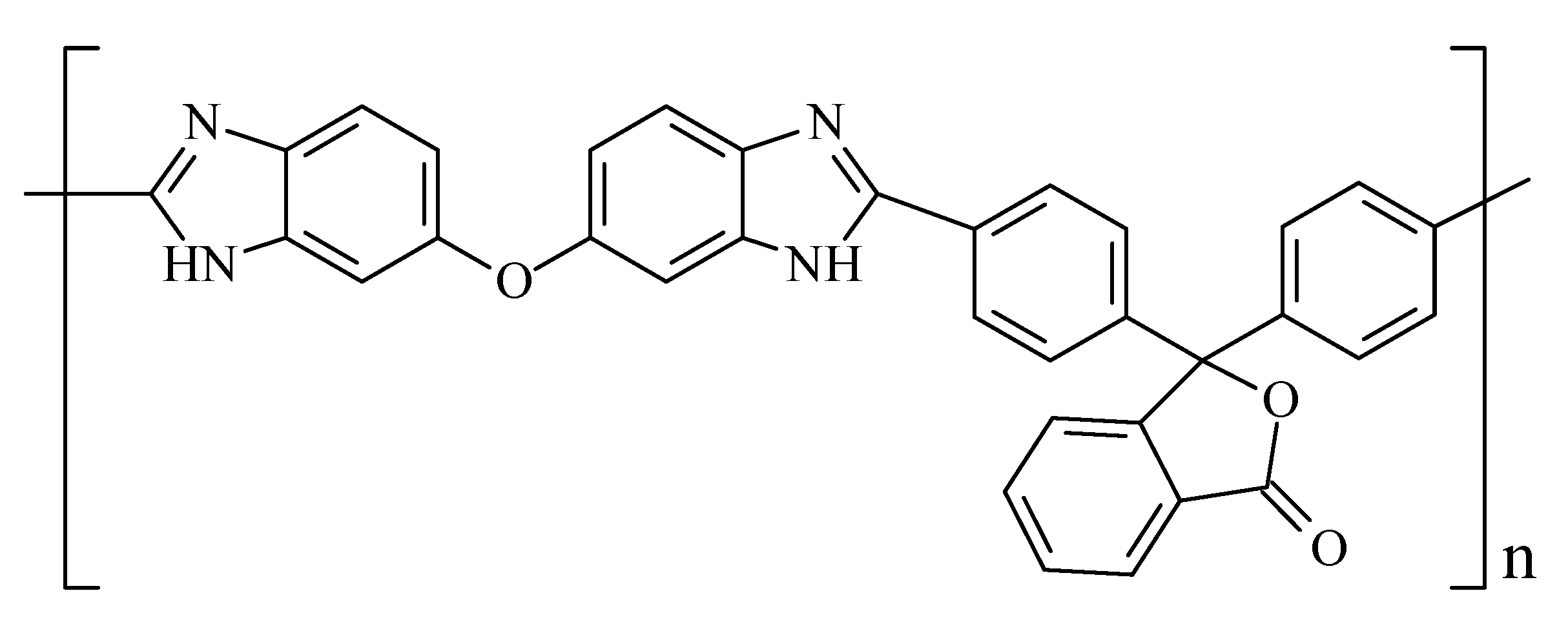
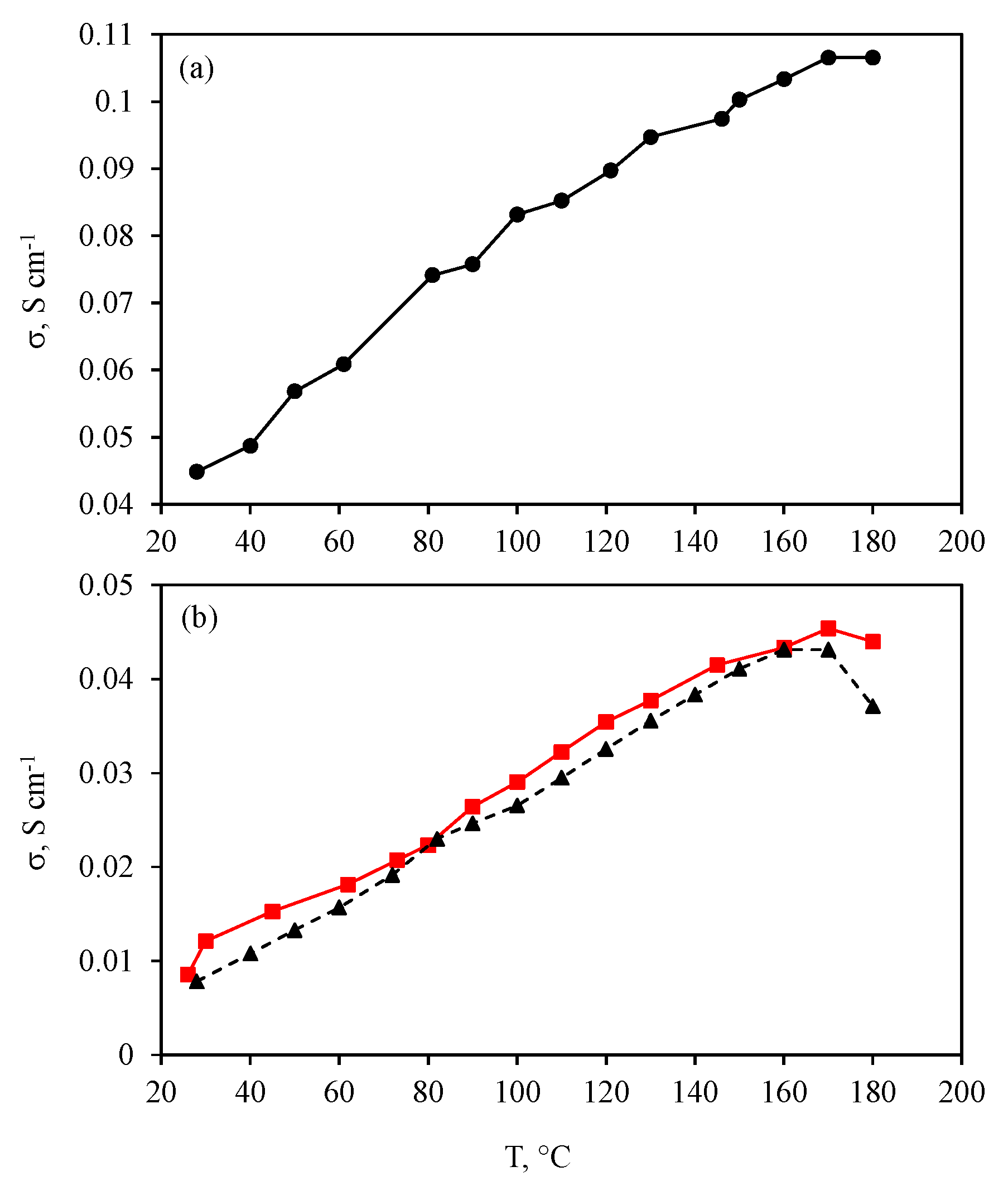
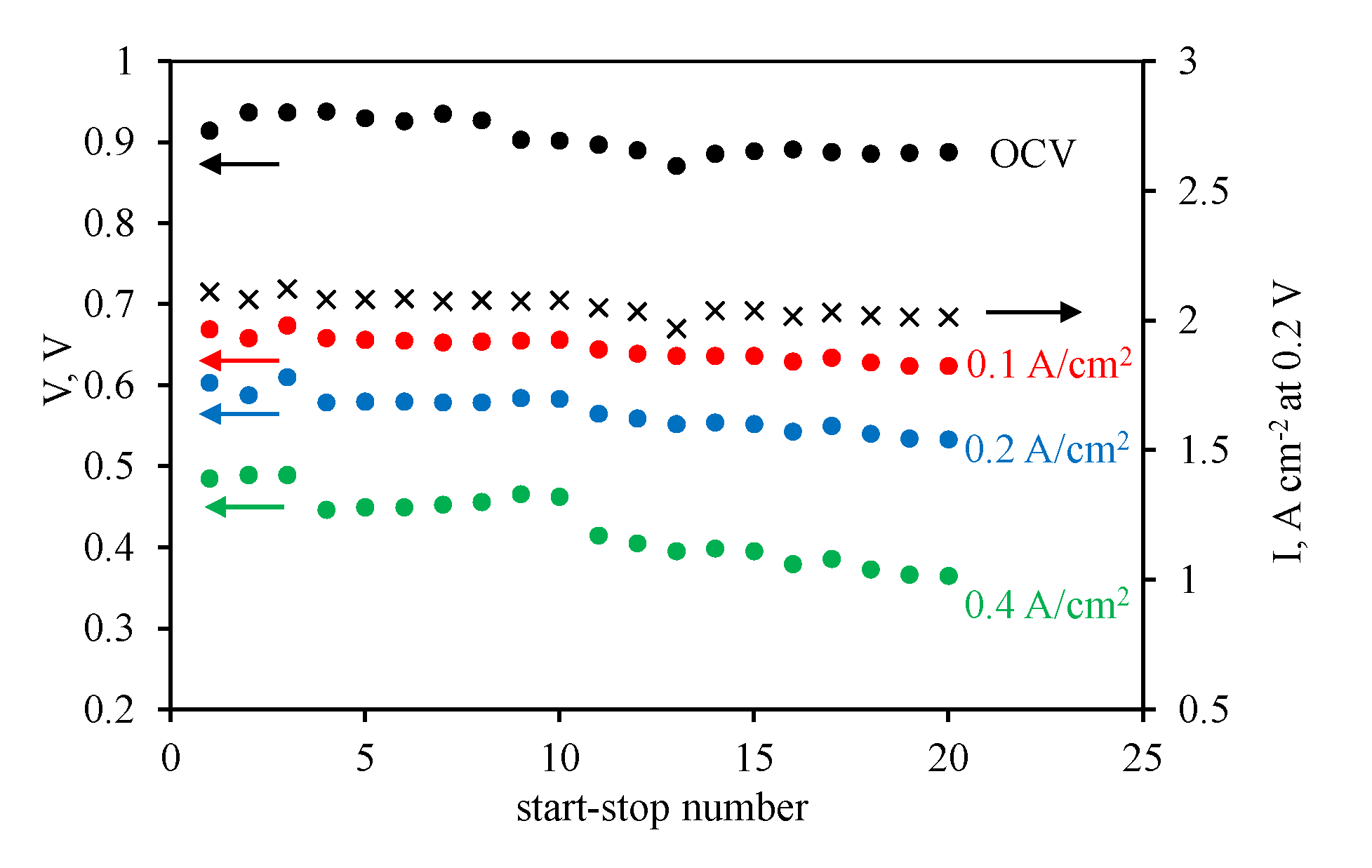
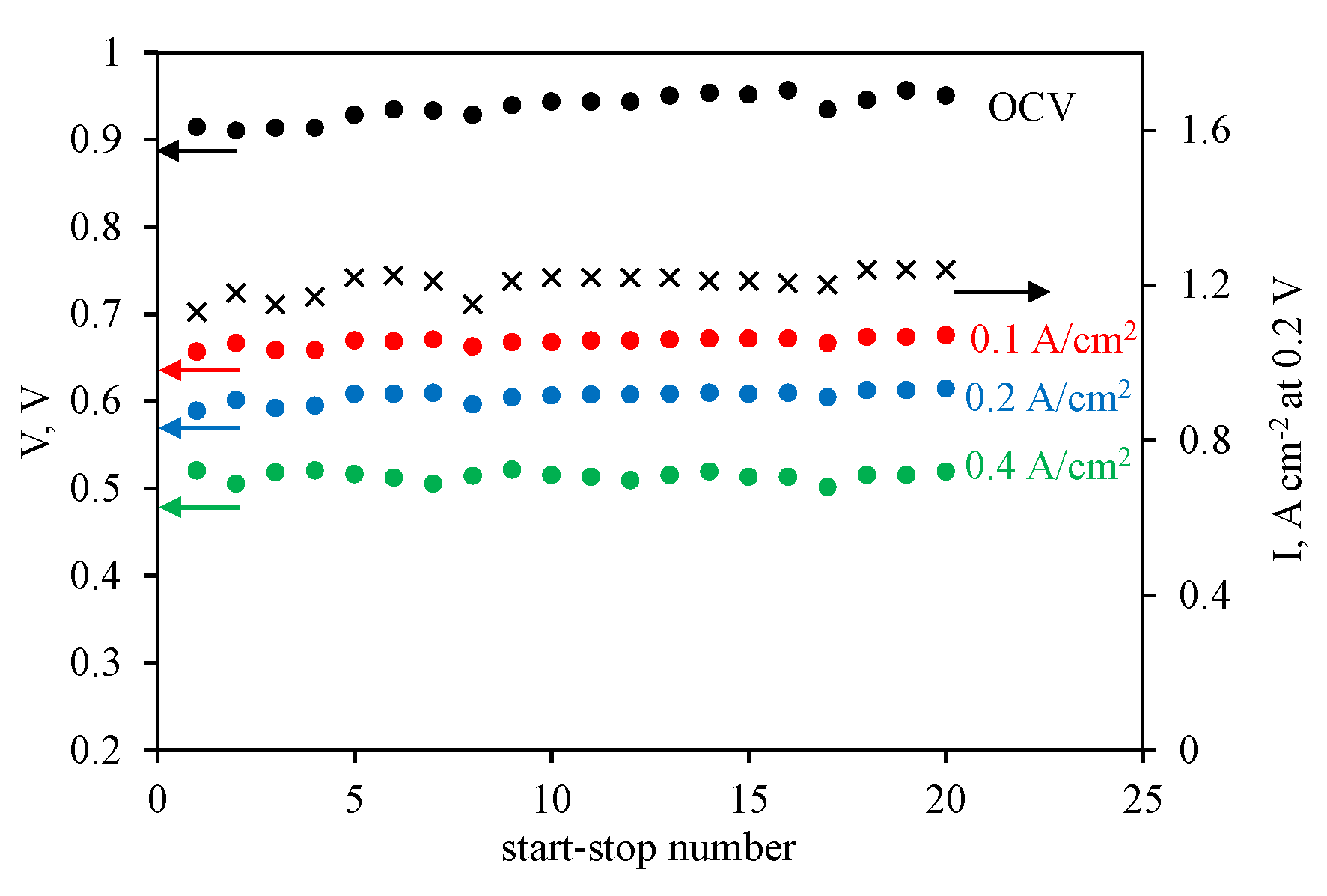
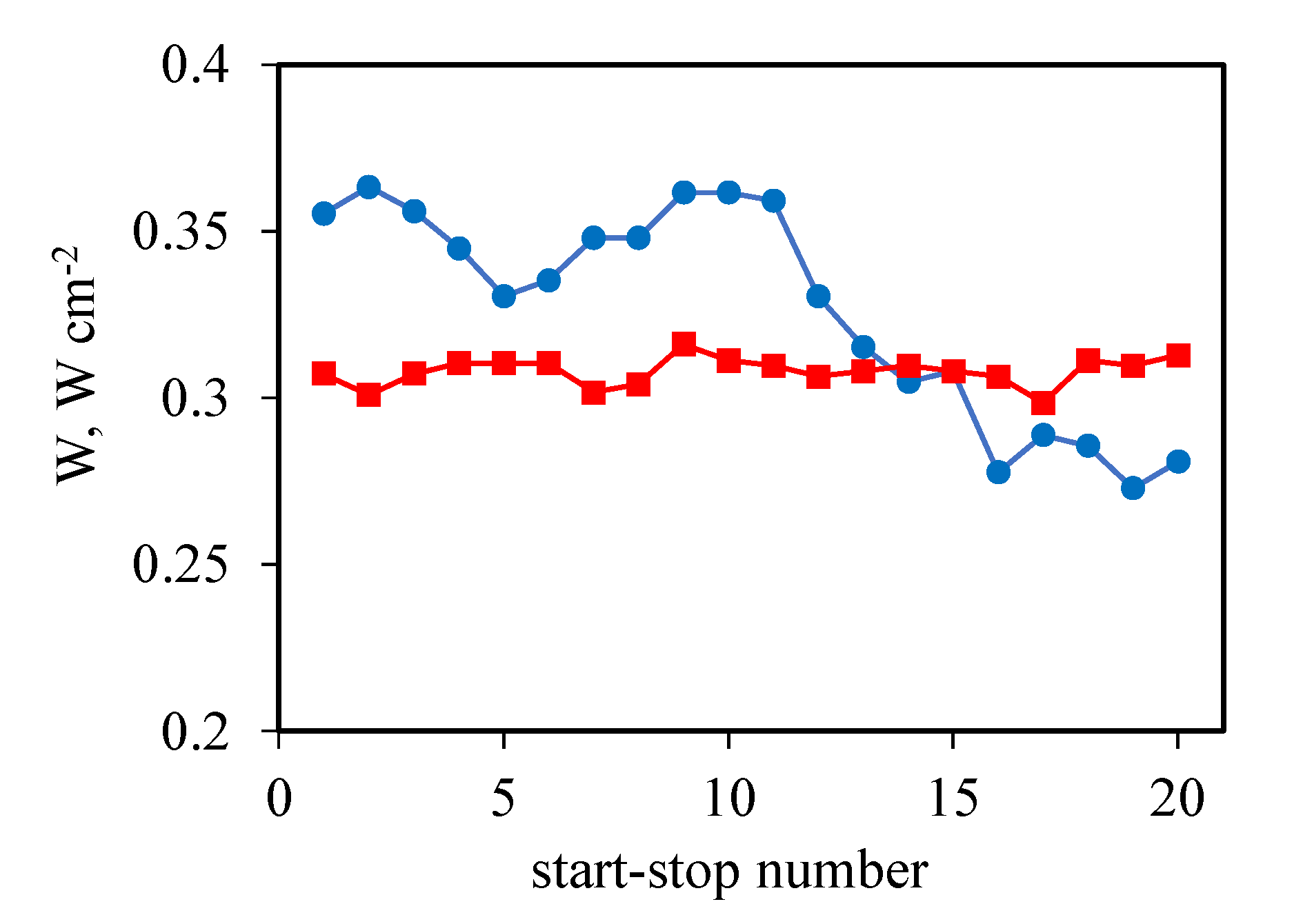

| Membrane | Gas | P at 30 °C, cm2 s−1 | P at 50 °C, cm2 s−1 |
|---|---|---|---|
| undoped | H2 | 3.4 × 10−8 | 5.1 × 10−8 |
| undoped | O2 | 1.1 × 10−8 | <10−8 |
| doped | H2 | 4.1 × 10−8 | 6.1 × 10−8 |
| doped | O2 | 2.5 × 10−8 | 3.4 × 10−8 |
| Cathode | Membrane | Rm, mΩ cm2 | Rm, mΩ cm2 (After Stress Tests) | H2 Crossover, mA cm−2 atm−1 | H2 Crossover, mA cm−2 atm−1 (After Stress Tests) | Ref. |
|---|---|---|---|---|---|---|
| P1000 1 | composite | 70 | 70 | 0.19 | 0.19 | this work |
| CNF | composite | 65 | 65 | 0.20 | 0.27 | this work |
| P1000 1 | PBI-O-PhT | ~60 | n/a | ~3 | n/a | [11] |
| P1000 1 | m-PBI (Celazole®) | ~55 | n/a | 4–5 | n/a | [44] |
Publisher’s Note: MDPI stays neutral with regard to jurisdictional claims in published maps and institutional affiliations. |
© 2022 by the authors. Licensee MDPI, Basel, Switzerland. This article is an open access article distributed under the terms and conditions of the Creative Commons Attribution (CC BY) license (https://creativecommons.org/licenses/by/4.0/).
Share and Cite
Ponomarev, I.I.; Skupov, K.M.; Modestov, A.D.; Lysova, A.A.; Ponomarev, I.I.; Vtyurina, E.S. Cardo Polybenzimidazole (PBI-O-PhT) Based Membrane Reinforced with m-polybenzimidazole Electrospun Nanofiber Mat for HT-PEM Fuel Cell Applications. Membranes 2022, 12, 956. https://doi.org/10.3390/membranes12100956
Ponomarev II, Skupov KM, Modestov AD, Lysova AA, Ponomarev II, Vtyurina ES. Cardo Polybenzimidazole (PBI-O-PhT) Based Membrane Reinforced with m-polybenzimidazole Electrospun Nanofiber Mat for HT-PEM Fuel Cell Applications. Membranes. 2022; 12(10):956. https://doi.org/10.3390/membranes12100956
Chicago/Turabian StylePonomarev, Igor I., Kirill M. Skupov, Alexander D. Modestov, Anna A. Lysova, Ivan I. Ponomarev, and Elizaveta S. Vtyurina. 2022. "Cardo Polybenzimidazole (PBI-O-PhT) Based Membrane Reinforced with m-polybenzimidazole Electrospun Nanofiber Mat for HT-PEM Fuel Cell Applications" Membranes 12, no. 10: 956. https://doi.org/10.3390/membranes12100956
APA StylePonomarev, I. I., Skupov, K. M., Modestov, A. D., Lysova, A. A., Ponomarev, I. I., & Vtyurina, E. S. (2022). Cardo Polybenzimidazole (PBI-O-PhT) Based Membrane Reinforced with m-polybenzimidazole Electrospun Nanofiber Mat for HT-PEM Fuel Cell Applications. Membranes, 12(10), 956. https://doi.org/10.3390/membranes12100956








